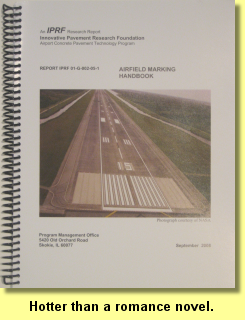 |
 |
Airfield Marking Handbook - Chapter 5By Mike Speidel
This piece is the fourth in a six article series summarizing each chapter contained within the Handbook. As the principal authors of the Airfield Marking Handbook, we will also be identifying key issues for your consideration.
Pavement Marking Removal In our Summer 2009 webletter, I discussed surface preparation and the value and longevity it can bring to a marking system's life cycle. Surface preparation is intended to clean the surface and also removes loose and flaking material from the pavement. Preparation often is misinterpreted as pavement marking removal because similar equipment is frequently used, and sometimes similar results are acheived. So to be clear, let's define exactly what should be acheived via marking removal. Chapter 5 addresses the removal (obliteration or eradication) of airfield markings from the pavement surface. There are several reasons for paint removal, as well as varying degrees of removal that may be required. Pavement marking removal is the mechanical eradication of markings from the pavement to a specified degree. This chapter affects everyone involved with markings; the design engineers, applicators, operations staff, and project inspectors. 
Not all removal efforts require 100 percent, 95, or even 85 percent removal of the markings. Two key factors to consider in a removal operation: 1) defining in the specifications what process is expected and 2) explaining exactly where and how much of the markings will be removed. For example, a marking that becomes obsolete should be removed 95-100%; when removing seal coats or other surface treatments, 80-85% should be removed. Paint removal is slower and more expensive than surface prepartion. An airport may have uses for multiple degrees of removal on one project, so it is important to specify what is needed in the initial specifications. No matter what degree of removal is called for, the operation should be followed by a cleaning operation to ensure all debris is collected and disposed of. It is very important to note in what condition the pavement underneath and adjacent to the marking is currently in. Asphalt in poor shape under or near the markings represents a pre-existing condition, and removal equipment such as a waterblaster may cause damage. Damage can be subjective in that marking removal will almost always scar the pavement. So the technical panel came up with definitions to distinguish the two. Scarring is removal of the texture that leaves some aggregate exposed. Damage occurs when more than 25 percent of the depth (vertical dimension) of the nominal-sized aggregate diameter is uniformly exposed across the pavement, and some of the aggregate could loosen. It is wise to have an operator perform a test strip with the removal equipment in order to establish expectations for the entire project initially. Want a handbook? Check this out. If you'd like a free handbook, just sign up for one of our Symposiums; it's the course literature. For details about the last seminar of the year, click on this link for the Mid-Atlantic Airfield Marking Symposium being held in Manassas, Virginia, October 19-21, 2009. |

 With the Airfield Marking Handbook hot off the presses and now being distributed to the industry, let's take a look at
what's inside. In each of the next several issues of Sightline's webletter, I'm going to take a look at each chapter and it's
highlights. It's the most comprehensive resource available dealing strictly with airfield markings. To obtain a copy,
With the Airfield Marking Handbook hot off the presses and now being distributed to the industry, let's take a look at
what's inside. In each of the next several issues of Sightline's webletter, I'm going to take a look at each chapter and it's
highlights. It's the most comprehensive resource available dealing strictly with airfield markings. To obtain a copy,